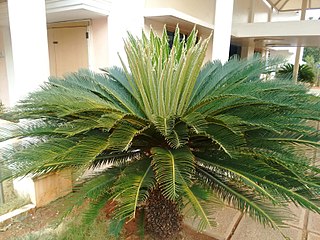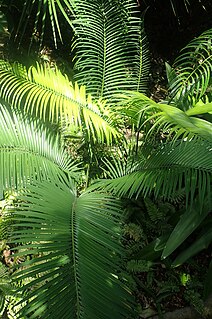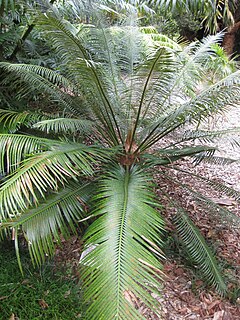
Cycas is a genus of plants belonging to a very ancient lineage, the Cycadophyta, which are not closely related to palms, ferns, trees or any other modern group of plants. They are evergreen perennials which achieved their maximum diversity in the Jurassic and Cretaceous periods, when they were distributed almost worldwide. At the end of the Cretaceous, when the non-avian dinosaurs became extinct, so did most of the cycas in the Northern Hemisphere.

Cycas balansae is a species of cycad in the genus Cycas, native to southwestern China and adjacent northern Vietnam, where it occurs in dense mountain rainforests.

Cycas beddomei is a species of cycad in the genus Cycas, native to India, where it is confined to a small area of Andhra Pradesh state in the Tirumala Hills in scrubland and brush covered hills.
Cycas cairnsiana is a species of cycad in the genus Cycas, native to northern Australia in northern Queensland on the Newcastle Range.

Cycas micronesica is a type of cycad found in the island of Yap in Micronesia, the Marianas islands of Guam and Rota, and The Republic of Palau. It is commonly known as Federico nut or Fadang in Chamorro. The species, previously lumped with Cycas rumphii or Cycas circinalis, was described in 1994 by Ken Hill. Paleoecological studies have determined that C. micronesica has been present on the island of Guam for about 9,000 years. It is linked with the human degenerative disease Lytico-Bodig disease, which is similar to amyotrophic lateral sclerosis (ALS) through a neurotoxin (BMAA) in the seeds, which were a traditional food source on Guam until the 1960s.

Cycas taitungensis is a species of genus Cycas endemic to Taitung County, south-eastern Taiwan. C. taitungensis, an evergreen tree, can grow up to about 5 m (16 ft) tall. The species was not described until 1994, but its specimen was once applied as the type of species Cycas taiwaniana, which is not really distributed in Taiwan according to the further research.

Cycas pectinata was the fourth species of Cycas to be named; it was described in 1826 by Scottish surgeon and botanist Francis Buchanan-Hamilton from Kamrup, Assam in northeast India. The species is one of the most widespread cycads. It is found in the northeastern part of India, Nepal, Bhutan, northern Burma, southern China (Yunnan), Bangladesh, Burma, Malaysia, Cambodia, northern Thailand, Laos, and Vietnam. Cycas pectinata usually grow at elevation 300 m to 1200 m and in difficult terrains. In China, it grows in dry, open thickets in limestone mountains, red soil in sparse monsoon forests. Cycas pectinata grows up to 40 feet (12 m) tall and has very large, ovoid male cones. The tallest Cycas pectinata is a female plant in North Kamrup, Assam which measures 52.8 feet (16.1 m). The tree is the world's tallest Cycas plant. In Northeast India, the species is under severe threat due to clearing of forest and over collection of male cones for preparation of traditional medicines. The species is listed in CITES Appendix II and IUCN Redlist.

Cycas thouarsii, the Madagascar cycad, is an evergreen arborescent cycad in the genus Cycas. It is named after a French botanist Louis-Marie Aubert du Petit-Thouars (1758—1831).

Cycas multipinnata is a species of cycad in southwestern China and northern Vietnam.

Cycas chevalieri is a species of cycad in central Vietnam, including in Nghe An Province. It may also occur in Laos.
Cycas diannanensis is a species of cycad endemic to Yunnan, China.
Cycas elephantipes is a species of cycad. It is found only on a few high sandstone mesas in Nong Bua Rawe District, Chaiyaphum Province, northeastern Thailand. It is morphologically similar to Cycas pachypoda from southern Vietnam.
Cycas elongata is a species of cycad endemic to southern Vietnam.

Cycas seemannii is a species of cycad found in Fiji, Vanuatu, Tonga, and New Caledonia.

Cycas guizhouensis is a species of cycad endemic to southwestern China.
Cycas fugax is a species of cycad endemic to Vietnam. It has only been recorded in the wild from Phu Tho Province, Vietnam, but may be reasonably common in cultivation in Hanoi.

Cycas wadei is a species of cycad endemic to Culion island, Philippines. There is only one subpopulation of about 5,000 mature individuals, located in a small area to the east of Halsey Harbor.
Cycas tropophylla, the Ha Long cycad, is a species of cycad endemic to Vietnam.
Cycas saxatilis is a species of cycad found only on Saint Paul's Mountain, Palawan, Philippines.











